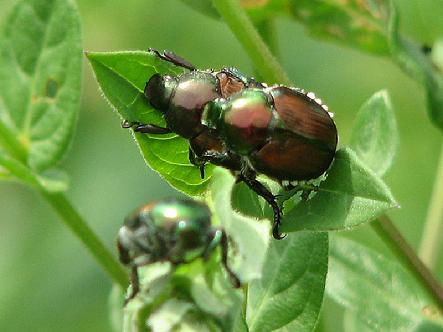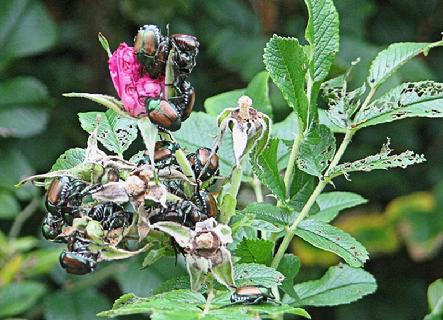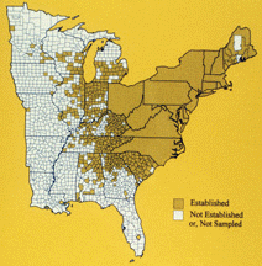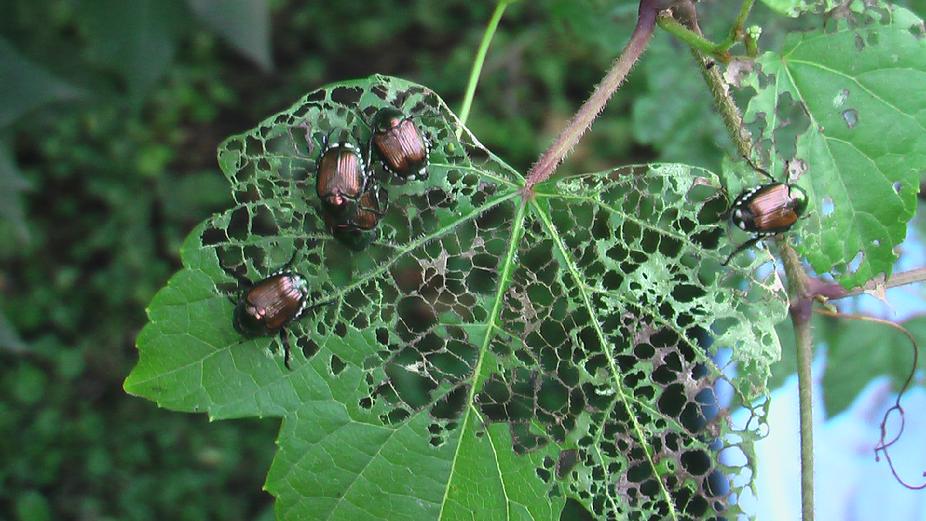Important Message
This Website Terms and Condition of Use Agreement
also known as a 'terms of service agreement'
Will be at the bottom of most web pages!
Please read it before using this website.
Thank You
|
|
My War on Japanese Beetles
Saving money on bags!
|
The beetle species Popillia japonica is commonly known as the Japanese beetle. It is about 15 millimetres (0.6 in) long and 10 millimetres (0.4 in) wide, with iridescent copper-colored elytra and green thorax and head. It is not very destructive in Japan, where it is controlled by natural predators, but in America it is a serious pest of about 200 species of plants, including rose bushes, grapes, hops, canna, crape myrtles, and others.
It is a clumsy flier, dropping several centimeters when it hits a wall. Japanese beetle traps therefore consist of a pair of crossed walls with a bag underneath, and are baited with floral scent, pheromone, or both. However, studies done at the University of Kentucky suggest traps attract more beetles than they actually trap, thus causing more damage along the flight path of the beetles and in the vicinity of the trap than may have occurred if the trap were not present.
These insects damage plants by skeletonizing the foliage, that is, consuming only the leaf material between the veins.
|
As the name suggests, the Japanese beetle is native to Japan. The insect was first found in the United States in 1916 in a nursery near Riverton, New Jersey. It is thought the beetle larvae entered the United States in a shipment of iris bulbs prior to 1912, when inspections of commodities entering the country began. "The first Japanese beetle found in Canada was in a tourist's car at Yarmouth, arriving in Nova Scotia by ferry from Maine in 1939. During the same year, three additional adults were captured at Yarmouth and three at Lacolle in southern Quebec."
|
 |
| Japanese beetles Mating |
|
|
 |
| Japanese beetles Feeding |
|
|
The life cycle of the Japanese beetle is typically one year in most parts of the United States, but this can be extended in cooler climates; for instance, in its native Japan, the beetle's life cycle is two years long as a result of the higher latitudes of the grasslands required for the larval stage. During the larval stage, the white grubs can be identified by their V-shaped raster pattern.
|
Life Cycle and Habits
The adult beetles normally emerge during the last week of June through July. The first beetles out of the ground seek out suitable food plants and begin to feed. These early arrivals begin to release an aggregation pheromone (odor) that attracts additional adults. Newly emerged females also release a sex pheromone that attracts males. After feeding and mating for a day or two, the females burrow into the soil to lay eggs at a depth of 2 to 4 inches. Females lay 1 to 5 eggs before returning to plants to feed and mate. This cycle of feeding, mating and egg laying continues until the female has laid 40 to 60 eggs. Most of the eggs are laid by mid-August though adults may be found until the first frost. The eggs hatch in 8 to 14 days and the first instar larvae dig to the soil surface to feed on roots and organic material. The first instars shed their skin (molt) in 17 to 25 days. The second instars take 18 to 45 days to mature and molt again. Most of the grubs are in the third instar by late September and by October they dig deeper into the soil to overwinter. The grubs return to the surface in the spring as the soil temperature warms, usually in mid-April. The grubs continue their development and form a pupa in an earthen cell 1 to 3 inches in the soil.
|
Mid-summer rainfall and adequate soil moisture are needed to keep eggs and newly-hatched grubs from drying out. Females are attracted to moist, grassy areas to lay their eggs; thus, irrigated lawns and golf courses often have high grub populations, especially during otherwise dry summers. Older grubs are relatively drought resistant and will move deeper into the soil if conditions become very dry. Japanese beetle grubs can withstand high soil moisture, so excessive rainfall or heavy watering of lawns does not bother them.
As Japanese beetle grubs chew off grass roots, they reduce the ability of grass to take up enough water to withstand the stresses of hot, dry weather. As a result, large dead patches develop in the grub-infested areas. The damaged sod is not well-anchored and can be rolled back like a carpet to expose the grubs. If the damage is allowed to develop to this stage, it may be too late to save the turf. Early recognition of the problem can prevent this destruction.
Japanese beetles overwinter in the grub stage. When the soil cools to about 60°F in the fall, the grubs begin to move deeper. Most pass the winter 2 to 6 inches below the surface, although some may go as deep as 8 to 10 inches. They become inactive when soil temperature falls to about 50°F.
When soil temperature climbs above 50°F in the spring, the grubs begin to move up into the root zone. Following a feeding period of 4-6 weeks, the grubs pupate in an earthen cell and remain there until emerging as adults
|
During the larval stage, the Japanese beetle lives in lawns and other grasslands, where it eats the roots of grasses. During that stage, it is susceptible to a fatal disease called milky spore disease, caused by a bacterium called milky spore, Paenibacillus (formerly Bacillus) popilliae. The USDA developed this biological control and it is commercially available in powder form for application to lawn areas. Standard applications (low density across a broad area) take from one to five years to establish maximal protection against larval survival (depending on climate), expanding through the soil through repeated rounds of infection, in-vers can be used to exclude the beetles; however, this may necessitate hand pollination of flowers. Kaolin sprays can also be used as barriers.
Research performed by many US extension service branches has shown pheromone traps attract more beetles than they catch. Traps are most effective when spread out over an entire community, and downwind and at the borders (i.e., as far away as possible, particularly upwind), of managed property containing plants being protected. Natural repellents include catnip, chives, garlic, and tansy, as well as the remains of dead beetles, but these methods have limited effectiveness. Additionally, when present in small numbers, the beetles may be manually controlled using a soap-water spray mixture, shaking a plant in the morning hours and disposing of the fallen beetles, or simply picking them off attractions such as rose flowers, since the presence of beetles attracts more beetles to that plant.
|
Adult ControlOption 1: Cultural Control - Hand Picking
By noticing when the first adults arrive on a property, you can pick off and destroy these scouts that attract additional pests. The adults are less active in the early morning or late evening. They can be destroyed by dropping into a container of soapy water.
Option 2: Cultural Control - Plant Non Attractive Plants
The adults do not like to feed on ageratum, arborvitae, ash, baby's breath, garden balsam, begonia, bleeding heart, boxwood, buttercups, caladium, carnations, Chinese lantern plant, cockscomb, columbine, coralbells, coralberry, coreopsis, cornflower, daisies, dogwood (flowering), dusty-miller, euonymus, false cypresses, firs, forget-me-not, forsythia, foxglove, hemlock, hollies, hydrangeas, junipers, kale (ornamental), lilacs, lilies, magnolias, maple (red or silver only), mulberry, nasturtium, oaks (red and white only), pines, poppies, snapdragon, snowberry, speedwell, sweet pea, sweet-William, tuliptree, violets and pansy, or yews (taxus).
Option 3: Cultural Control - Trapping
Several traps using a floral lure and sex attractant are available. These traps are not recommended for general use unless special conditions can be met. The traps have been demonstrated to be effective in reducing damage and populations only when landscapes are isolated from other Japanese beetle breeding areas or when mass trapping (everyone in the neighborhood) is used. In most urban areas, traps tend to attract more beetles into the area than would normally be present. In this situation, adult feeding and resultant grub populations are not reduced.
Option 4: Chemical Control - Insecticide Spraying
The adults can be controlled by spraying susceptible plants with insecticides. Over-the-counter pesticides available for this include: acephate (Orthene), carbaryl (Sevin), and several pyrethroids - bifenthrin, cyfluthrin, deltamethrin, lambda-cyhalothrin, permethrin, and others. Applications of imidacloprid (=Bayer Advanced Tree & Shrub Concentrate) generally need to be made 20 days before anticipated Japanese beetle adult activity. During the heavy adult activity periods, sprays may be needed every 5 to 10 days.
Grub ControlOption 1: Biological Control - Bacterial Milky Disease
The bacterial milky diseases, Bacillus popilliae Dutky, has been quite effective at controlling the grubs in certain areas of the eastern United States. The spore count must build up for 2 to 3 years to be very effective and during this time you should not use an insecticide against the grubs that are needed to complete the bacterium cycle. In Ohio and Kentucky, test trials have not produced satisfactory results. Additional experiments are needed to determine the lack of efficacy of milky disease in these soils.
Option 2: Biological Control - Entomopathogenic Nematodes
Insect parasitic nematodes have recently become commercially available. Products that contain strains of Steinernema carpocapsae (Biosafe, Biovector, Exhibit, Scanmask) have been marginally effective against white grubs in turf. Preparations containing Heterorhabditis spp. seem to be more effective. Apply the nematodes when the white grubs are small. Irrigate before and after applying the nematodes.
Option 3: Chemical Controls - Insecticides
The grubs are best controlled when they are small and actively feeding near the soil surface, usually late July to mid-August. However, with the development of new grub control chemistry (e.g., imidacloprid [Merit] and halofenozide [MACH2]), applications in June and July have sufficient residual activity to kill the new grub populations as they come to the soil surface in late July through August. Control of grubs in late-fall or early-spring is difficult, at best, because the grubs are large and may not be feeding. Only trichlorfon (Dylox) and carbaryl (Sevin) formulations are available for such rescue treatments. The key to good control is to make an even application and water thoroughly.
|
 |
| Map showing the parts of the United States currently infested by Japanese beetles. |
|
|
Japanese Beetle Management for Minnesota
Click Here
|
Japanese beetles feed on a large range of hosts, including leaves of plants of the following common crops:
Beans, strawberries, tomatoes, peppers, grapes, hops, roses, cherries, plums, pears, peaches, raspberries, blackberries, corn, peas, blueberries, and these genera:
|
- Abelmoschus
- Acer
- Aesculus
- Alcea
- Aronia
- Asparagus
- Aster
- Betula (birch trees)
- Buddleja
- Calluna
- Caladium
- Canna
- Chaenomeles
- Cirsium
- Cosmos
- Crab Apple
- Dahlia
- Daucus
- Dendranthema
- Digitalis
- Dolichos
- Echinacea
|
- Hemerocallis
- Heuchera
- Hibiscus
- Humulus
- Hydrangea
- Ilex
- Impatiens
- Ipomoea (morning glory)
- Iris
- Lagerstroemia
- Liatris
- Ligustrum
- Malus (apple)
- Malva
- Myrica
- Ocimum (basil)
- Oenothera
- Parthenocissus
- Phaseolus
- Phlox
- Physocarpus
- Pistacia
- Platanus
- Polygonum
- Populus
- Prunus
|
- Quercus
- Ribes (gooseberry, currants, etc.)
- Rheum
- Rhododendron
- Rosa
- Rubus (raspberry, blackberry, etc.)
- Salix (willows)
- Sambucus
- Sassafras
- Solanum
- Syringa
- Thuja (arborvitae)
- Tilia (linden, lime, or basswood trees)
- Toxicodendron
- Ulmus
- Vaccinium
- Viburnum
- Vitis
- Weigelia
- Wisteria
- Zea
- Zinnia
|
 |
| Leaves skeletonized by Japanese beetles |
|
|
Careful selection of plant species when replacing or adding to your landscape is the key to avoiding annual battles with Japanese beetles. Some species and cultivars are highly preferred by the adults and should be avoided where the beetle is abundant. Plants that are especially prone to damage include roses, grapes, lindens, sassafras, Norway maple, Japanese maple, purple-leaf plum, and others (Table 1). Many varieties of flowering crabapples are also severely attacked by the beetles, although some cultivars are resistant.
|
| Table 1. Landscape Plants Likely to be Attacked by Adult Japanese Beetles. |
| Scientific name |
Common name |
| Acer palmatum |
Japanese maple |
| Acer platanoides |
Norway maple |
| Aesculus hippocastanum |
Horsechestnut |
| Althaea rosea |
Hollyhock |
| Betula populifolia |
Gray birch |
| Castanea dentata |
American chestnut |
| Hibiscus syriacus |
Rose-of-Sharon, Shrub Althea |
| Juglans nigra |
Black walnut |
| Malus species |
Flowering crabapple1, apple |
| Platanus acerifolia |
London planetree |
| Populus nigra italica |
Lombardy poplar |
| Prunus species |
Cherry, black cherry, plum, peach, etc. |
| Rosa species |
Roses |
| Sassafras albidum |
Sassafras |
| Sorbus americana |
American mountain ash |
| Tilia americana |
American linden2 |
| Ulmus americana |
American elm |
| Ulmus procera |
English elm |
| Vitis species |
Grape |
| 1Some cultivars (e.g. Baccata v. jackii, Jewelberry, Harvest Gold, Louisa) are relatively resistant. See Kentucky Cooperative Extension Service publication ID-68, "The Flowering Crabapple," for more information.
2Tilia tomentosa 'Sterling' and Tilia americana 'Legend' are less susceptible than other lindens.
|
Fortunately, many common trees and shrubs are much less attractive to Japanese beetles (Table 2). These differences in susceptibility should be considered when selecting plant species and cultivars for use in Japanese beetle-infested areas.
| Table 2. Landscape Plants Seldom Damaged by Adult Japanese Beetles. |
| Scientific name |
Common name |
| Acer negundo |
Boxelder* |
| Acer rubrum |
Red maple |
| Acer saccharinum |
Silver maple |
| Buxus sempervirens |
Boxwood |
| Carya ovata |
Shagbark hickory* |
| Cornus florida |
Flowering dogwood |
| Diospyros virginiana |
Persimmon* |
| Euonymus species |
Euonymus (all species) |
| Fraxinus americana |
White ash |
| Fraxinus pennsylvanica |
Green ash |
| Ilex species |
Holly (all species) |
| Juglans cinerea |
Butternut* |
| Liriodendron tulipifera |
Tuliptree |
| Liquidamar styraciflua |
American sweetgum* |
| Magnolia species |
Magnolia (all species) |
| Morus rubra |
Red Mulberry |
| Populus alba |
White poplar |
| Pyrus communis |
Common pear* |
| Quercus alba |
White oak* |
| Quercus coccinea |
Scarlet oak* |
| Quercus rubra |
Red oak* |
| Quercus velutina |
Black oak* |
| Sambucus canadensis |
American elder* |
| Syringa vulgaris |
Common lilac |
| Most evergreen ornamentals, including Abies (fir), Juniperus, Taxus, Thuja (arbor vitae), Rhododendron, Picea (spruce), Pinus (pine) and Tsuga (hemlock) are not attacked.
*Species marked with an asterisk may suffer occasional light feeding.
|
|
 |
| Japanese beetles - not a good bug, or just plain evil? |
|
|
Fast becoming more of a nuisance around St. Paul, the Japanese beetle is a destructive, exotic pest harming turf, shrubs, and trees. Thought to be established only in isolated areas within St. Paul, there recently have been more instances of infestations. The City of St. Paul is monitoring these areas and management options are being discussed to minimize the impact of the Japanese beetle. Click Here for more...
|
|
Japanese Beetle Trap from Beetle Bagger!
|
|
Saving money on bags!
by reusing your bags
|
By placing your full Japanese Beetles bags in a 1 gallon Ice cream bucket and placing the bucket in your freezzer over night will allow you to reuse your bags. Wash your Japanese Beetles bags before reusing.
|
Sue Writes,
Can the Beetle Bagger Japanese Beetle Trap be used in the house, specifically the kitchen?
Answer:
No, you would not want to place the Beetle Bagger Japanese Beetle Trap Kit inside your home. The lure, or bait that is added to the trap that attracts the beetles, does have an odor, so you would not want the smell in your home. Also you would not want to place the trap in your home because you would attract beetles inside your home.
Answer last updated on: 07/30/2011
|
|
Japanese Cedar Longhorn Beetle
Coming Soon
|
 |
| Previous Page |
|
| New to this Website
|
 |
| Next Page |
|
|
 |
| New to this Website |
|
|
This website contains, in various sections, portions of copyrighted material not specifically authorized by the copyright owner. This material is used for educational purposes only and presented to provide understanding or give information for issues concerning the public as a whole. In accordance with U.S. Copyright Law Title 17 U.S.C. Section 107, the material on this site is distributed without profit. More Information
Information presented based on medical, news, government, and/or other web based articles or documents does not represent any medical recommendation or legal advice from myself or West Saint Paul Antiques. For specific information and advice on any condition or issue, you must consult a professional health care provider or legal advisor for direction.
I and West Saint Paul Antiques can not be responsible for information others may post on an external website linked here ~ or for websites which link to West Saint Paul Antiques. I would ask, however, that should you see something which you question or which seems incorrect or inappropriate, that you notify me immediately at floyd@weststpaulantiques.com Also, I would very much appreciate being notified if you find links which do not work or other problems with the website itself. Thank You!
Please know that there is no copyright infringement intended with any part of this website ~ should you find something that belongs to you and proper credit has not been given (or if you simply wish for me to remove it),
just let me know and I will do so right away.
|
Website Terms and Condition of Use Agreement
also known as a 'terms of service agreement'
By using this website, West Saint Paul Antiques . Com, you are agreeing to use the site according to and in agreement with the above and following terms of use without limitation or qualification. If you do not agree, then you must refain from using the site.
The 'Terms of Use' govern your access to and use of this website and facebook pages associated with it. If you do not agree to all of the Terms of Use, do not access or use the website, or the facebook sites. By accessing or using any of them, you and any entity you are authorized to represent signify your agreement to be bound by the Terms of Use.
Said Terms of Use may be revised and/or updated at any time by posting of the changes on this page of the website. Your continued usage of the website, or the facebook site(s) after any changes to the Terms of Use will mean that you have accepted the changes. Also, any these sites themselves may be changed, supplemented, deleted, and/or updated at my sole discretion without notice; this establishes intellectual property rights by owner (myself).
It saddens me to include a Terms of Use for West Saint Paul Antiques . Com, but we all realize it is something that is necessary and must be done these days. By using the website, or facebook for West Saint Paul Antiques, you represent that you are of legal age and that you agree to be bound by the Terms of Use and any subsequent modifications. Your use of the West Saint Paul Antiques sites signify your electronic acceptance of the Terms of Use and constitute your signature to same as if you had actually signed an agreement embodying the terms.
|
|
 |
| Me with your feedback on how I can Improve this website. |
|
| |
|